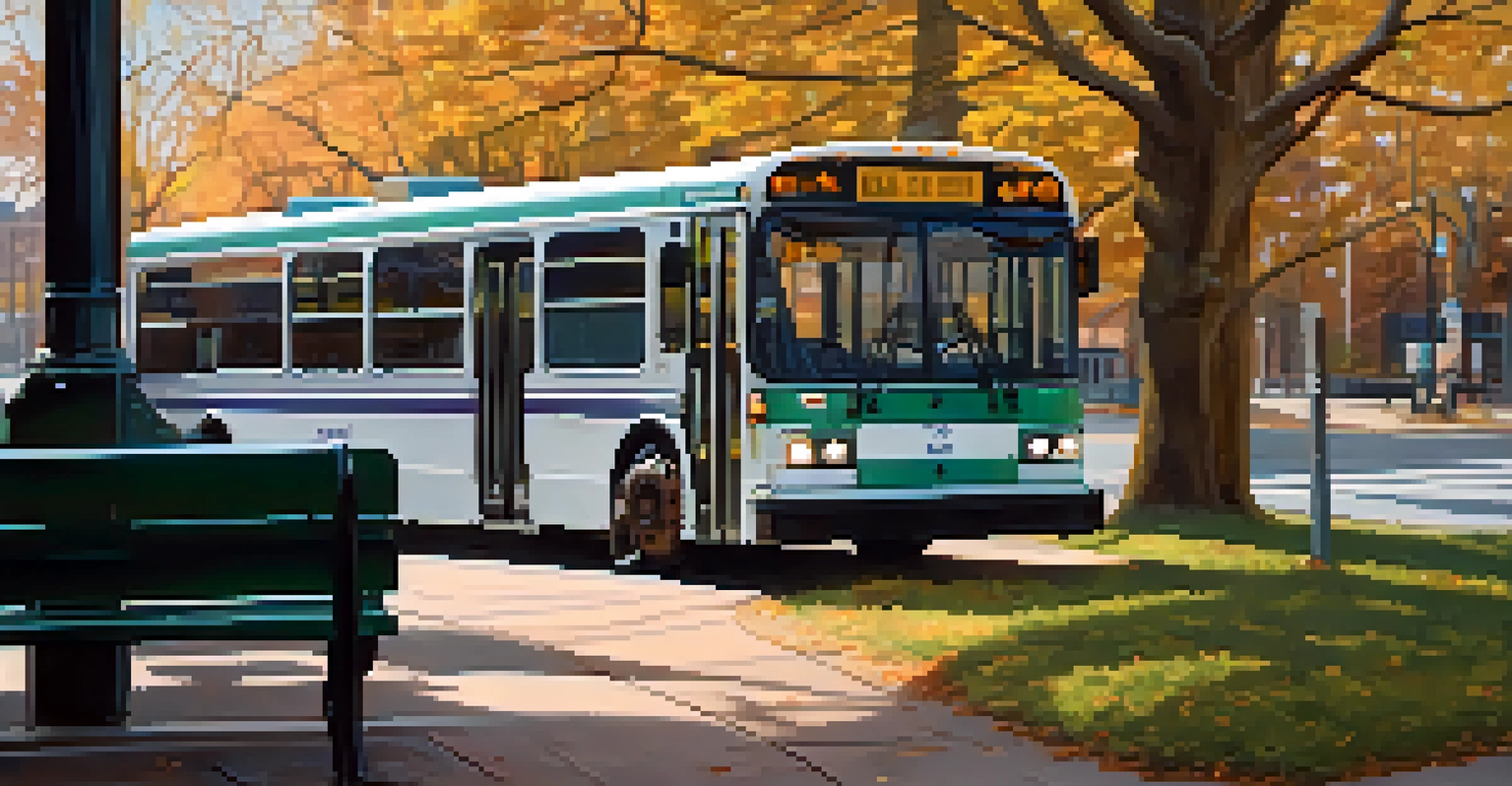Impact of COVID-19 on MBTA Public Transportation Services

Overview of MBTA Before the Pandemic
Before COVID-19, the Massachusetts Bay Transportation Authority (MBTA) was a vital lifeline for commuters in the Boston area. With a diverse range of services, including buses, subways, and commuter rail, MBTA facilitated millions of rides daily. Its efficiency made public transport a preferred choice for many, contributing significantly to the region's economy and reducing traffic congestion.
Public transportation is the backbone of a city, and the MBTA is a vital part of that infrastructure.
However, the vibrant daily ridership also posed challenges, such as overcrowding during peak hours. The system had been working on improving infrastructure and service frequency to meet the growing demand. Little did anyone know that a global pandemic was on the horizon, ready to turn the world of public transportation upside down.
As the pandemic approached, discussions about MBTA's future and the resilience of its services were already brewing. The agency had to prepare for an unprecedented event that would reshape public transportation in the years to come.
Immediate Effects of COVID-19 on MBTA Operations
When COVID-19 hit, MBTA faced immediate challenges, including a sharp decline in ridership. As residents began to work from home and schools shuttered, the once-busy trains and buses became eerily empty. This sudden drop not only impacted the agency's revenue but also raised concerns about the sustainability of its operations.

To adapt, MBTA implemented measures like reduced service frequencies and the suspension of certain routes. This was a difficult decision, but it was necessary to ensure the safety of both commuters and staff. The agency aimed to remain responsive while navigating the complexities of a rapidly changing environment.
COVID-19 Impacted MBTA Operations
The pandemic caused a drastic decline in ridership, prompting MBTA to reduce services and focus on safety measures.
In addition to service reductions, MBTA also ramped up cleaning protocols to ensure vehicles and stations were sanitized regularly. This focus on health and safety became paramount as they sought to rebuild trust with the public.
Changes in Ridership Patterns Post-Pandemic
As restrictions eased, MBTA witnessed shifts in ridership patterns that were both surprising and revealing. Many former commuters had adopted remote work, leading to a permanent decrease in weekday traffic. Interestingly, weekends saw a resurgence as people sought leisure activities outside their homes, prompting MBTA to rethink its service offerings.
The future of public transportation relies on understanding the needs of the community it serves.
This change highlighted the evolving needs of the community, with more focus on flexible schedules and expanded services during weekends. The agency began to explore new strategies to accommodate these shifts, ensuring that they could meet the demands of an increasingly dynamic population.
MBTA's efforts to understand these new patterns involved gathering data and feedback from riders. This engagement was crucial in shaping the future of public transportation in a post-pandemic world.
Health and Safety Protocols Implemented by MBTA
In response to COVID-19, MBTA introduced several health and safety protocols designed to protect riders and staff alike. Mask mandates and social distancing measures became the norm as passengers boarded vehicles. The agency also installed hand sanitizer dispensers at stations, making hygiene more accessible for everyone.
These efforts were complemented by an aggressive cleaning regimen, which saw trains and buses disinfected multiple times a day. MBTA aimed to create a safe environment for commuters, encouraging them to return to public transportation with confidence.
Shifts in Ridership Patterns
Post-pandemic, MBTA observed a permanent decrease in weekday ridership while weekend usage surged, leading to a reevaluation of service offerings.
Additionally, communication was key; MBTA rolled out campaigns to keep the public informed about safety measures. This transparency helped build trust and gradually restored ridership levels.
Impact on MBTA's Financial Stability
The financial repercussions of COVID-19 on MBTA were significant and multifaceted. With ridership plummeting, the agency faced a stark decline in fare revenues, forcing it to reevaluate its budget and priorities. The reliance on public funding became even more apparent as the agency looked for ways to sustain operations amidst the crisis.
To navigate this financial strain, MBTA sought federal assistance and explored cost-cutting measures. This included reducing operational expenditures while still trying to maintain essential services for those who relied on public transportation. The challenge was to balance fiscal responsibility with the commitment to serve the community.
As MBTA worked through these financial hurdles, it also focused on long-term strategies to recover and grow post-pandemic. The goal was not only to stabilize but to emerge stronger, ensuring that public transportation remained a viable option for all.
Community Engagement and Feedback during the Pandemic
Throughout the pandemic, MBTA understood the importance of community engagement. They actively sought feedback from riders to understand their changing needs and concerns. This engagement was facilitated through surveys and outreach initiatives, helping to create a dialogue between the agency and the public.
The insights gained from this feedback were invaluable, guiding MBTA's decision-making processes. Understanding rider preferences and safety concerns allowed the agency to tailor its services more effectively. This adaptability was crucial in maintaining a connection with the community during uncertain times.
Financial Challenges for MBTA
With fare revenues plummeting, MBTA faced significant financial strain and sought federal assistance while prioritizing essential services.
Moreover, MBTA's efforts to involve the public in discussions about service changes fostered a sense of ownership among riders. This collaborative approach was essential in rebuilding trust and ensuring that public transportation met the evolving needs of the community.
Looking Ahead: The Future of MBTA Services
As we look to the future, MBTA is focusing on recovery and innovation in public transportation. The pandemic has prompted a reevaluation of service models, emphasizing flexibility and rider needs. MBTA aims to enhance its offerings based on the new ridership patterns established during the pandemic.
Investments in technology and infrastructure are also on the horizon. Enhancing digital tools for ticketing and real-time tracking can improve the overall rider experience. MBTA recognizes that adapting to the changing landscape of public transportation is vital for long-term sustainability.

Ultimately, the goal is to create a resilient public transportation system that can withstand future challenges. By prioritizing community input and embracing innovation, MBTA is positioning itself to meet the needs of its riders well into the future.